Activity Map of ArCS II Project
– Towards a New Horizon of Arctic Research –
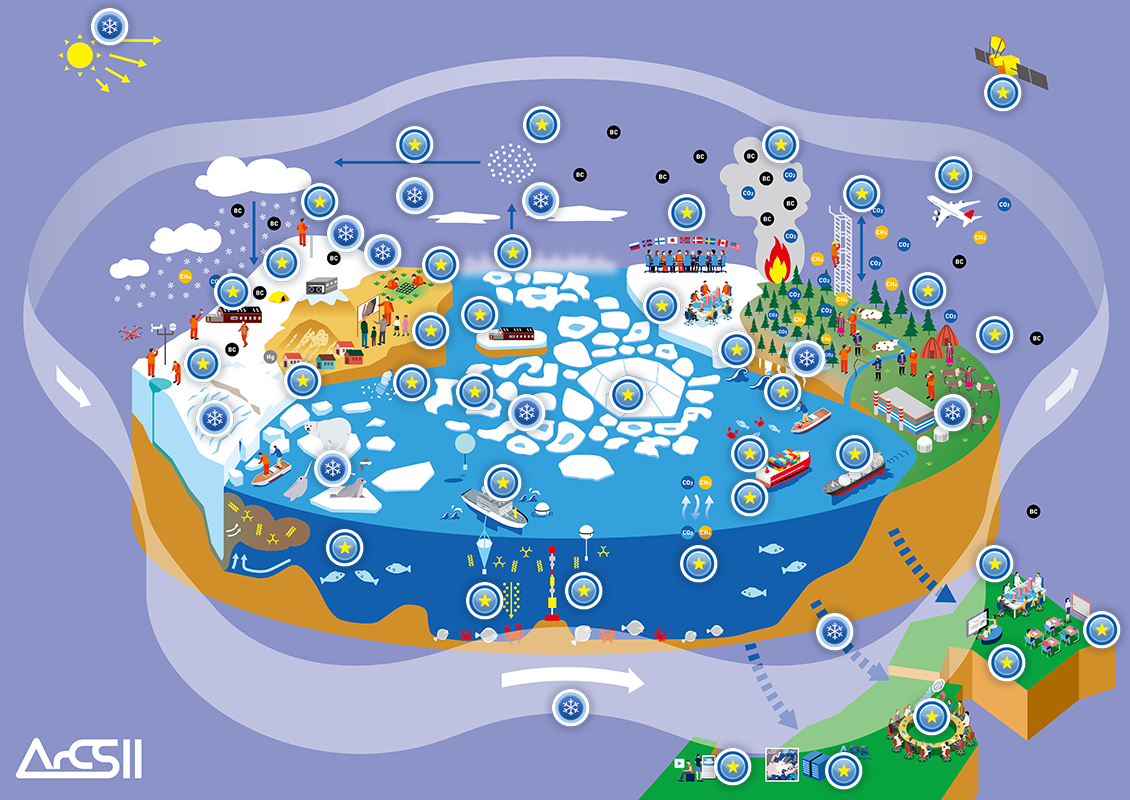
Solar radiation
The sun emits various electromagnetic waves – visible light, ultraviolet rays, infrared rays, etc. This is called solar radiation. In the Arctic, snow and ice reflect solar radiation, creating a cold climate. However, due to recent global warming, the covering of snow and ice is decreasing, and solar radiation is being absorbed by the earth surface, causing the snow/ice albedo feedback to amplify warming in the Arctic.
CLOSE
Understanding how Black Carbons, clouds, and aerosols changes
Atmospheric substances and clouds, such as greenhouse gases and aerosols in the Arctic atmosphere, probably have a significant impact on the Arctic climate. We aim to understand how these atmospheric substances and clouds change and what causes the changes.
CLOSE
What causes clouds?
Aerosols in the atmosphere are the cores of cloud formation. They cause water vapor to transform into water droplets and ice particles that arise cloud formation. Since cloud formation is related to the radiative process of the atmosphere, it is a major research target for climate change. Various studies have been conducted on the effects of airborne materials from the Arctic oceans and land, and polluting aerosols from the mid-latitudes surrounding the Arctic on cloud formation.
CLOSE
Aerosols
Fine particles floating in the atmosphere are called aerosols. Aerosols include sand dust, volcanic ash, salt from seawater (sea salt particles), and sulfate particles from exhaust gases. In the summer in the Arctic region, the ground where the ice has melted releases substances that form aerosols, which contain the biologically derived substances that are excellent for forming ice crystals.
CLOSE
Observation of CO2・CH4 flux

The greenhouse gases, such as carbon dioxide (CO2) and methane (CH4), move over land, the atmosphere, oceans, and forests and we are monitoring these fluxes, the amount of these gases. Continuous monitoring of these fluxes is important for elucidating the effects of climate change. The flux observation towers in Russia and Alaska are the research platform of ArCS II.
CLOSE
Aircraft observation
Observation devices are attached to the aircraft to obtain BC (black carbon) and carbon dioxide data that cannot be captured by ground-based observations in a wide range and at high frequency.
CLOSE
JAXA earth observation satellites

Earth observation satellites observe various aspects of the Earth from the space. Earth observation satellite data is mandatory for snow and sea ice observation, which is essential for research in the Arctic region, as well as for the observation of topographical changes caused by thawing permafrost, atmospheric environmental substances (aerosols), and greenhouse gases. These data are used to understand the changes in snow and ice, to predict the condition of the Arctic Sea Route, and to prevent disaster events.
CLOSE
The westerilies meadering
The westerlies are air currents that circulate around the Earth in a westerly direction at the boundary between the North Pole and the mid-latitudes, and there is a strong jet stream in the upper troposphere. Changes in the generation of heat and water vapor in the polar regions due to sea ice loss, etc., can affect the pressure pattern and cause the westerlies to meander. This can cause abnormal weather in Japan, such as cold waves and heavy snowfall in winter, high temperatures and heavy rainfall in summer.
CLOSE
Improvement of weather and climate prediction methods
We will scientifically elucidate the origins and mechanisms of changes in the Arctic environment, and improve numerical simulations for research and development of accurate weather and climate prediction methods. The improved prediction technology will enable us to cope with environmental changes in the Arctic region and disasters caused by extreme events outside the Arctic region.
CLOSE
Research of fishery resources
The northern sea is a rich fishing ground that supports the livelihood of people. We will understand how global warming and sea ice loss in the Arctic affect the marine ecosystem in the region, and predict what will happen to fishery resources in the future.
CLOSE
Analysis on resource development
It draws much attention to development of submarine resources due to sea ice loss. However, it has been pointed out that easy development can cause serious damage to the environment and ecosystems in the Arctic, and there is a risk of expanding environmental changes in the entire globe. We will consider the optimal combination of resource use and environmental conservation.
CLOSE
Economical/risk analysis on Arctic sea route
As sea ice in the Arctic Ocean is decreasing, it is expected that more vessels will use Arctic sea routes in the future. In order to select safe and economical routes and vessels, we will provide sea ice information in the routes and evaluate the performance and safety of vessels based on academic knowledge. We will also evaluate the economic feasibility of using the Arctic sea routes.
CLOSE
Navigation support
Ships and tankers other than icebreakers are not able to go through where there is sea ice in the Arctic Ocean. We are conducting research to support safe navigation in the Arctic Ocean by providing satellite observation data and forecasts of sea ice distribution in the Arctic Ocean.
CLOSE
Estimation of carbon dioxide absorbed/emitted from ocean
Carbon dioxide in the atmosphere is partly absorbed into the oceans, but it is predicted that its absorption capacity will decrease as global warming progresses. It is important to constantly monitor the absorption and release of greenhouse gases such as carbon dioxide and methane in the ocean.
CLOSE
Provideng information on AGREEMENT TO PREVENT UNREGULATED HIGH SEAS FISHERIES IN THE CENTRAL ARCTIC OCEAN
In order to prevent unregulated fishing in the high seas in the central Arctic Ocean, ten countries and organizations, including the Arctic coastal states, the EU, and Japan, have concluded AGREEMENT TO PREVENT UNREGULATED HIGH SEAS FISHERIES IN THE CENTRAL ARCTIC OCEAN. The latest information on this agreement is collected and provided here.
CLOSE
Observation facilities

Data collection through observation in the Arctic and its analysis are essential for Arctic research.
In addition to the Ny-Ålesund Station in Svalbard, the observation facilities operated and maintained in cooperation with research institutes in Arctic countries will be utilized as a base for international collaboration.
In addition to the Ny-Ålesund Station in Svalbard, the observation facilities operated and maintained in cooperation with research institutes in Arctic countries will be utilized as a base for international collaboration.
CLOSE
Observation and prediction of weather and sea ice
We continuously observe the weather and sea ice in the Arctic Ocean through on-site observations in the Arctic, observations by icebreakers, and satellite-based observations, aiming to improve the accuracy of predicting the weather in the Arctic region and sea ice distribution in the Arctic Ocean.
CLOSE
Observation by R/V "MIRAI" and other vessels

Oceanographic research vessel MIRAI and other observation vessels conduct observation voyage in the Arctic Ocean to carry out oceanographic and meteorological observations. By conducting observation voyages every year, we are accumulating continuous data.
CLOSE
Oceanographic observation

Oceanographic observation in the Arctic Ocean is conducted to capture the ongoing environmental changes in the Arctic Ocean in detail. We measure the temperature, salinity, and chemical composition of seawater, conduct plankton netting, and collect mud from the seafloor to understand the actual state of the ocean. In addition, observation equipment is moored in the seawater for a certain period to capture changes in the marine environment.
CLOSE
Marine ecosystem research

We will research the changes in the marine environment caused by sea ice loss and how these changes affect the ecosystem, from plankton to fish and their predators: whales and seabirds.
CLOSE
Elucidating interaction between glaciers and ocean
Glaciers and ice sheet in the Arctic have been rapidly decreasing in recent years, and the meltwater that flows into the sea causes changes in ocean circulation and ecosystems. To elucidate these phenomena, we conduct field surveys and use satellite data for research.
CLOSE
Risk analysis of environmental changes

We quantify the impact of glacial flooding and thawing of the permafrost on the marine environment, and clarify the response to various environmental changes occurring in the Arctic and future disaster risks.
CLOSE
Terrestrial observation
To understand the actual conditions and mechanisms of changes in the Arctic cryosphere, we observe the effects of snow and ice microorganisms and light-absorbing aerosols on albedo, snow cover/property.
CLOSE
Researchof terrestrial ecosystem
To understand how terrestrial plant ecosystems function in tundra and forests, we promote new field observations and utilize long-term observation data and remote sensing data.
CLOSE
Workshops with Arctic communities
We hold workshops designed to give back research results to Arctic communities affected by climate change, to contribute to a sustainable Arctic future.
CLOSE
Ice core analysis

Snow accumulation over many years forms ice sheets and glaciers. Ice core drilling is digging out long ice columns from them. By analyzing ice cores, we can obtain time-series data and spatial distribution data on the phenomena of various environmental changes on Earth.
CLOSE
Observation of Black Carbon (BC)
Black carbon (BC) particles come out when burning fossil fuels, etc. Forest fires are also the cause of them. Black carbon (BC) on snow and ice may accelerate the melting of them, having a significant impact on environmental changes in the Arctic.
CLOSE
How does the change of glaciers and ice sheets affect the ocean?

Glaciers and ice sheets in the Arctic are decreasing due to rapid global warming, which causes significant changes in the terrestrial water cycle and ecosystem. Ice-melt water flows into the ocean with sediment. The melt water into ocean causes sea levels to rise. We clarify the mechanism of how glacier and ice sheets melt and their actual conditions.
CLOSE
Dispatching experts to international conference
We dispatch experts to international conferences to discuss various topics in the Arctic and provide the results of our research. The results of Japan’s Arctic research contribute to various international reports.
CLOSE
International research exchange

By conducting International Research Exchange program with overseas Arctic research institutions, we aim to build an international joint research system and an international human network to strengthen our research capabilities and foster young researchers.
CLOSE
An interdisciplinary approach to environmental changes
Researchers from the natural, humanity, and social sciences will collaborate to understand the actual state of environmental change and provide the results to the Arctic community.
CLOSE
Materials for environmental education

Along with research results, we provide photographs and information obtained during field observations and surveys in the Arctic to local communities as educational materials for thinking about the environment.
CLOSE
The impact of Arctic environmental changes on Japan's weather
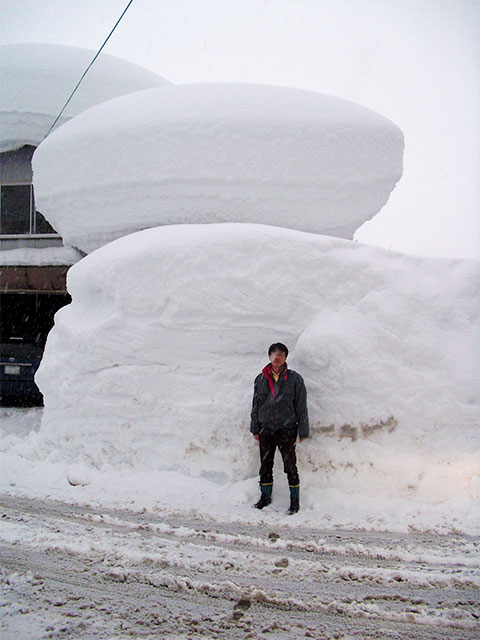
Research has shown that environmental changes in the Arctic are responsible for the heavy rains and snowfalls that have occurred frequently in Japan in recent years. We research the impact of Arctic environmental changes on Japan's weather and use this information to predict cold waves and heavy snowfalls in winter and heatwaves and heavy rainfall in summer.
CLOSE
Education and outreach
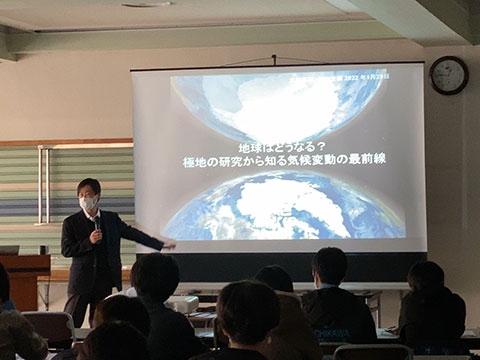
Various educational and outreach activities communicate our research results and the latest information so that more people will be interested in the climate and environmental changes in the Arctic.
CLOSE
International research exchange
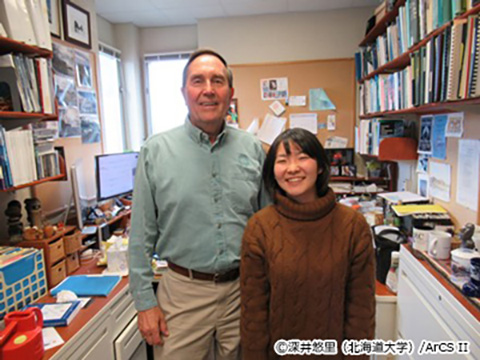
To foster young researchers for future research in the Arctic, we support their research themes, as well as provide opportunities for urgent, challenging research topics, and promote research exchange programs between domestic and overseas research institutions.
CLOSE
Providing information to government officials
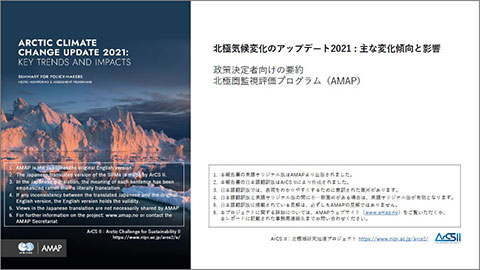
Experts attending various international conferences on the Arctic, such as the Arctic Council and its working groups, will exchange opinions with government officials to contribute to Japan's Arctic policy.
CLOSE
Arctic research database
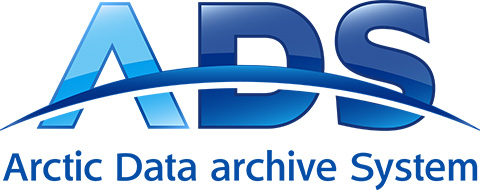
A variety of data from Arctic research and observation is compiled into a database and made widely available through web services to promote the distribution of research data and its use by researchers.
CLOSE
Arctic Information Websites
The "Arctic Environmental Information Website" is a portal site of Arctic information, including the latest research results and news regarding the Arctic from worldwide. The Arctic Sea Ice Information Center provides specialized information on Arctic sea ice, such as the forecast of Arctic sea ice distribution.
CLOSE
Interaction among atmosphere, ocean, and sea ice
The more sea ice extent decreases due to global warming, the more heat and water vapor exchange between the ocean and the atmosphere. We will research this phenomenon to elucidate how ocean heat and water vapor cause changes in atmospheric circulation and how the atmosphere affects the ocean and sea ice.
CLOSE
Cold air blow
In a winter monsoon, the stronger the Siberian High pressure becomes, the more cold air blows into East Asia, including Japan. When the Siberian High protrudes the mid-latitudes by meandering westerly winds, it can bring heavy snowfall to Japan.
CLOSE
Sea ice
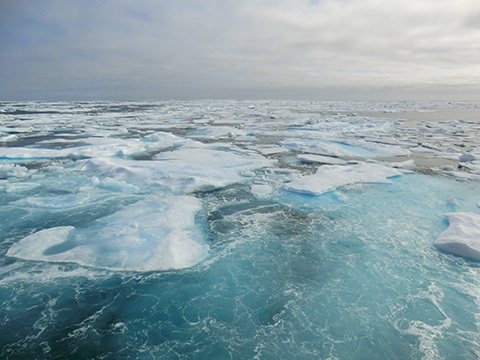
Sea ice is frozen seawater and widely covers the Arctic Ocean. In recent years, Arctic sea ice extent in summer has been decreasing, which is considered an effect of global warming. Sea ice has a remarkable influence on the heat balance of the polar oceans; it suppresses the temperature rise in summer by reflecting solar radiation and prevents heat loss from the ocean in winter. Sea ice decrease will cause rapid warming, leading to an amplification of Arctic warming that will accelerate the warming process.
CLOSE
Glacier
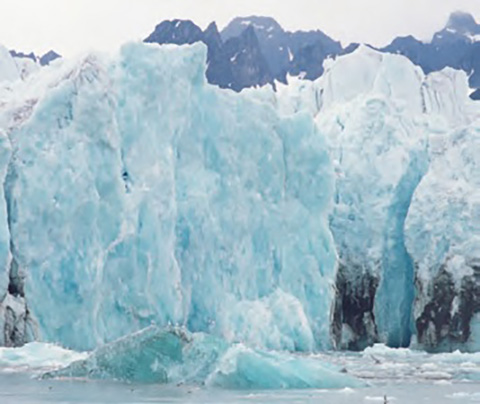
The snow that falls on mountains in cold regions accumulates to form ice and moves slowly. It is called a glacier. The Arctic, which is home to many glaciers, is currently experiencing the fastest temperature rise on Earth. Melting water from glaciers affects the sea level rise and the marine environment as well as cause floods and affect areas where people live.
CLOSE
Ice sheet
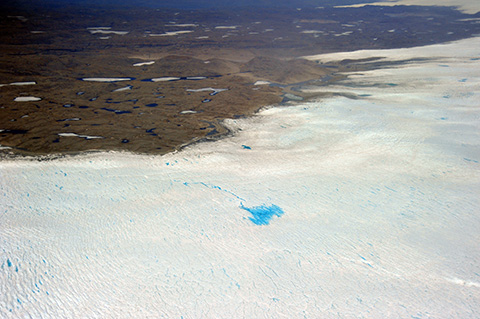
The ice covering Greenland and Antarctica is particularly huge and is called "ice sheet." The weight of the entire ice sheet causes it to move slowly toward the ocean. Greenland ice sheet mass is decreasing due to global warming, which affects the oceans as meltwater flows into them. These changes are also affecting the lives of the people living in Greenland.
CLOSE
Tundra
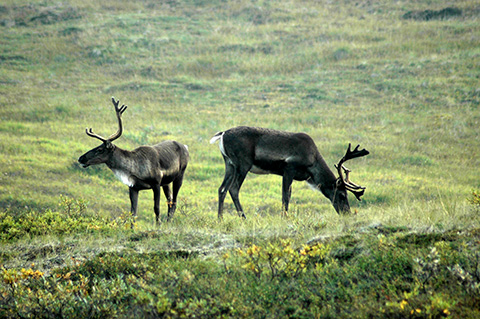
Tundra is a land with frozen ground and little rainfall. It covers most of the area in the Arctic. In the short summer season, the surface thaws, and mosses, lichens, and short grasses grow in some areas.
CLOSE
Arctic animals
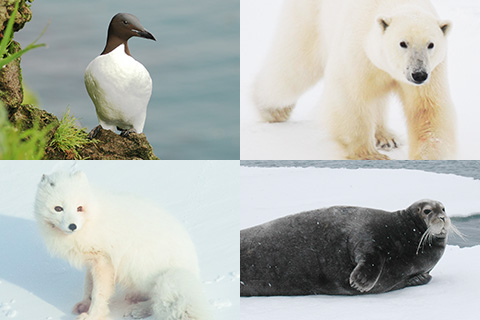
The Arctic is home to many species of animals that have adapted to the cold climate, including polar bears, arctic foxes, and reindeer. In the ocean, whales, seals, walruses, narwhals, and belugas can be seen.
CLOSE
Albedo
The fraction of the light reflected by something is called albedo. The earth absorbs about 70% of the radiant energy from the sun and reflects 30% on average, so the albedo is 30%. The oceans, which make up about 70% of the earth's surface, generally reflect less than 10%, but snow and ice have high reflectance ranging from 30% to 90%, thus increasing the reflectance of the entire earth and deterring global warming.
CLOSE
Ice albedo feedback
As global warming progresses and the snow and ice melt, the Earth's albedo will decrease, then absorption of solar radiation energy on the Earth's surface will increase, which accelerates global warming. This phenomenon is called ice-albedo feedback. It is necessary to monitor changes in the distribution of snow and ice in the Arctic to curb global warming.
CLOSE
Stormy waves in the Arctic Ocean
With the decrease of sea ice in the Arctic Ocean during the summer, more ships use the Arctic sea route. But the stormy waves (high waves) are also increasing year by year. The waves in the Arctic hinder sailing. Another problem is that splashed seawater freezes on ships. We research to understand and predict the characteristics of these waves.
CLOSE
Forest fires
In recent years, summer heatwaves and forest fires in areas close to the Arctic Circle have been in the news frequently. Aerosols from forest fires are the cause of climate change and have a significant impact on the Arctic atmosphere. Research on predicting heatwaves and forest fires will contribute to countermeasures against air pollution in and around the Arctic.
CLOSE
Plastic pollution of the Arctic Ocean
The Arctic is no exception to the problem of marine plastic pollution, and large amounts of microfibers (synthetic fiber fragments) have existed in the seawater of the Arctic Ocean. To elucidate the impact of this plastic pollution on the Arctic ecosystem, a plastic pollution investigation has started since the 2020 MIRAI observation voyage.
CLOSE